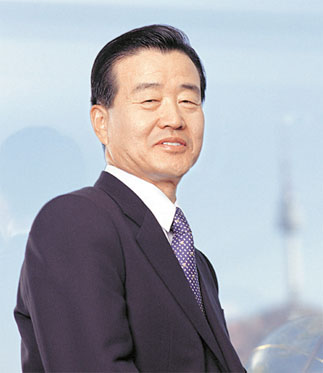Stability is key to success

Ra Eung-chan (70)
Founded in 1982, the late-comer bank was a David in front of Goliath compared with the cash-laden banks at the time: Chohung Bank, Commercial Bank of Korea, Korea First Bank, Hanil Bank and Seoul Bank.
Since then, these five institutions have suffered a series of setbacks. They either have changed their names, fully or partly, or have disappeared after merging with another lender or being purchased by the government amid financial turbulence.
Years leading up to the Asian financial crisis in the late 1990s in particular rearranged the landscape of the local banking industry. Shinhan was a slight exception.
According to some industry watchers, the bank, hard-wired to a philosophy that puts steadiness ahead of aggression, has put an appetite for risk in check, which they say has enabled the bank’s strong growth.
The bank has cleared much of the bad loans incurred during the 1997-98 financial crisis. In April 1999, one year after the crisis, the bank issued $400 million global depositary receipts, succeeding in borrowing the biggest-ever amount of overseas loans for a local bank, which the company cites as evidence of the Shinhan’s credibility.
Based on this success, the bank ventured to be a financial holding firm in September 2001, a first for an independent bank.
Under the wing of Shinhan Financial Group, Shinhan Bank took over Chohung Bank, the oldest local bank, between 2003 to 2006. As of the end of last year, it had 249 trillion won in assets, the third largest among local lenders, and 10,926 employees at 1,025 branches.
Not only expansion, but diversification is another key word explaining Shinhan’s growth. With takeovers of Goodmorning Securities in 2002, Shinhan Life Insurance in 2005 and LG Card in 2006, among others, Shinhan Financial Group is now a comprehensive financial service provider with 10 other affiliates other than the bank. It also has a capital firm and an asset manager as subsidiaries. The size of the group’s assets were 314 trillion won as of June.
For a company growing on M&As, Shinhan’s stability is exceptional, some analysts say. After all, engulfing another company and absorbing employees accustomed to a different corporate culture is often risky. For instance, when it was reborn after the merger with the 108-year-old Chohung Bank in 2006, the market assessed the move as unusually calm and successful. It even became a sample case studied by Harvard Business School students as an example of a successful M&A.
The merger with LG Card, then the biggest local credit card firm, in October 2007 gave birth to the biggest card firm in Asia and one of the top 10 across the globe. As of June, the number of Shinhan Card subscribers was 13.87 million.
The card firm has 16 trillion won in assets. Its asset managing arm was created in the mid-1990s and began to grow substantially in 2001 when it forged a partnership with Paris-based BNP Paribas. In January, Shinhan BNP Paribas Investment Management took over SH Asset Management, another local asset manager, and was reborn as the country’s third largest asset manager. As of the end of July, the company managed 34.43 trillion won worth of assets.
In the second quarter, Shinhan Financial Group posted a 349.7 billion won net profit, a 272 percent growth from a quarter earlier. The banking arm posted 174 percent growth in net profits to 202 billion won.

Lee Jae-woo, sixth from left, president of Shinhan Card, pumps fist with teenagers the company selected for the Beautiful Adolescents Award at the headquarters of the card firm in Chungmuro, central Seoul, in this Aug. 4 file photo. Since 2006, Shinhan, in partnership with Holt Children’s Services, a charity for orphans, has given awards annually to underprivileged teenagers who take care of themselves despite difficult circumstances. Provided by the company
It also plans to provide more comprehensive and diversified investment-banking services.
The name-change of Goodmorning Shinhan Securities into Shinhan Investment Corporation that takes effect tomorrow shows the determination of the company, officials say.
“Compared with other financial holding firms, Shinhan Financial Group has stable financial conditions and management and solid fundamentals,” said Seo Young-soo, an analyst at Kiwoom Securities. “We will see whether it can do as well on the global stage as it has at home.”
What’s not well known is the founding fathers of Shinhan Bank are Korean-Japanese businessmen, such as Lee Heui-keon, now honorary chairman of the bank. The 92-year-old Lee and some fellow Korean-Japanese founded Jeil Investment and Finance in 1977 in Korea. The assets were used to launch Shinhan Bank five years later.
According to the Shinhan group, the portion of shares held by Lee and the Korean-Japanese financiers are still around 20 percent, forming the largest shareholding group. Based on the capital from Japan, Ra Eung-chan, a close aide to Lee who served as an executive at Jeil Investment and Finance, transformed Shinhan into a sizeable lender.
Ra, serving as president of the bank, is now chairman of Shinhan Financial Group.
Because of the connection with Korean-Japanese shareholders, working in Japanese branches is considered an inevitable path for success at Shinhan, and many of the executives of the company spent large portions of their careers in Japan. Another unique feature among Shinhan executives is the fact that some of them graduated from commercial high schools.
Shin Sang-hoon, president of Shinhan Financial Group, is another leading contributor to Shinhan’s growth. He first set foot in the finance industry with Korea Development Bank in 1967. Joining as the inaugurating member of Shinhan bank in 1982, he served executive managing director from 2001, president of the bank from 2003, and president of the holding firm from March.
Lee Baek-soon, president of Shinhan Bank, is the face of Shinhan. With a 38-year career as banker, 27 years of which he spent at Shinhan.
Lee Jae-woo, president of Shinhan Card, is another founding member of Shinhan Bank. He served as chief communication officer of the bank from 2001, an executive managing director of the holding firm from 2004, vice president of the holding firm from 2006 and head of the card firm from October of 2007.
Job experiences at various fields earned Suh Jin-won, president of Shinhan Life Insurance, the nickname “all-around player,” but he still has one specialty standing out among other things in the Information Technology field. He was credited with laying the groundwork for the company’s online banking system.

Han Do-heui, president of Shinhan Capital, is known for thoughtful consideration toward the employees. His work philosophy is TPF: trust, pride and fun.
Choi Bhang-gil, president of Shinhan BNP Paribas Investment Management, expresses his management philosophy as customer-centric asset management. Choi targets to lift the asset manager into top position in the local asset management market with a market share 15 percent by 2012.
*“Faces inside Korea’s conglomerates,” a regular weekly series about key figures in the nation’s major companies, will also feature major figures within Korea’s large financial groups.
By Moon Gwang-lip [joe@joongang.co.kr]










with the Korea JoongAng Daily
To write comments, please log in to one of the accounts.
Standards Board Policy (0/250자)